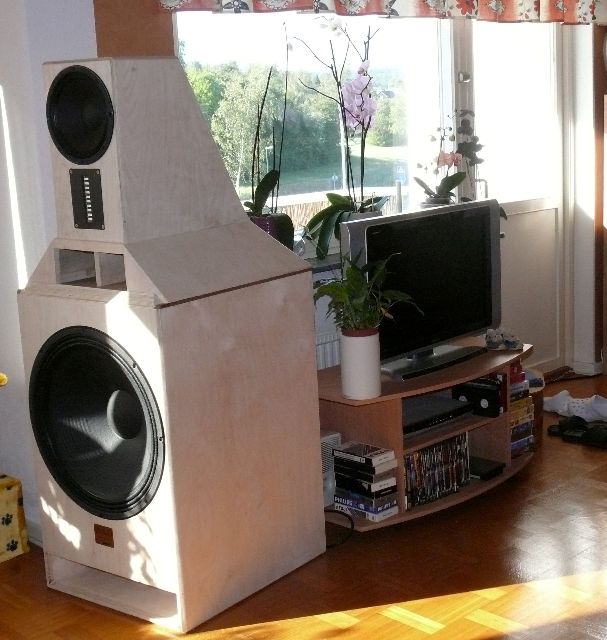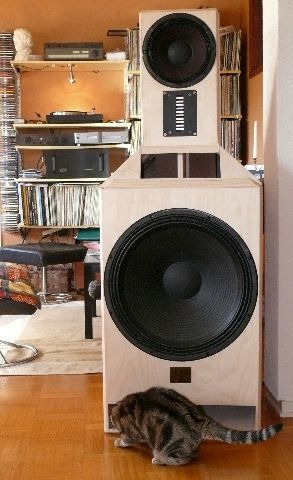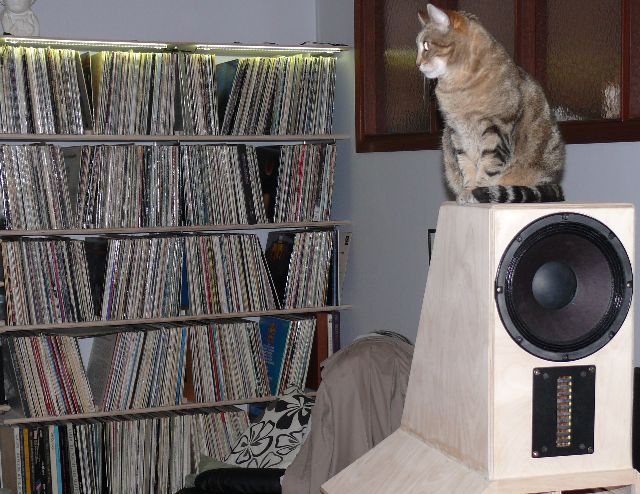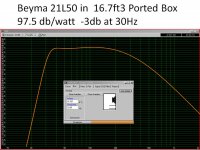it does look really good with its small 3" voice coil, and single spider
tried a calculation
hard to squeeze much deep bass out of that one
maybe 0.27 Qts is a bit on the low side to do ordinary vented BR
Got any pro setup pics?
The reall large stuff is seldom for installation, its on the road, but the tings i really like doing: here´s just a few, most pictures at the jobserver and i seldom remember how to log in from here, will put a few more up tomorrow, there should be some build pics of the large stuff too.
This, PM-4, might be my absolute favourite realy small speaker, designed for use on wall or very close.





But of course! That's where you put the ....The JMMLC looks like a baby birds beak
.
.
.
.
.
.
tweeter.
This is an installation a like a lot.
A fairly large hall in the citizens house in a small village on the westcoast.

This is used most days of the week, dance, live music, movie and theatre.
Place is run on a non commercial basis so budget wasn´t unlimited.
The speakers each side of stage, this is during installation, are TQWT´s pipe length a bit above 200cm, ML with port downwards close to the wall.
LF unit Beyma 12G40 and HF Beyma CD10Nd.
Halfway on the sidewalls smaller monitors with same LF and Beyma CP25.

Lurking under stage is a 350cm subhorn with Beyma 15LX60.

3x Peavey PV2000 driving, Peavey processor for x-over and delay to time align speakers.
Sounds really nice, like a big home setup buth with brutal power and nice acoustics in the hall.
A fairly large hall in the citizens house in a small village on the westcoast.

This is used most days of the week, dance, live music, movie and theatre.
Place is run on a non commercial basis so budget wasn´t unlimited.
The speakers each side of stage, this is during installation, are TQWT´s pipe length a bit above 200cm, ML with port downwards close to the wall.
LF unit Beyma 12G40 and HF Beyma CD10Nd.
Halfway on the sidewalls smaller monitors with same LF and Beyma CP25.

Lurking under stage is a 350cm subhorn with Beyma 15LX60.

3x Peavey PV2000 driving, Peavey processor for x-over and delay to time align speakers.
Sounds really nice, like a big home setup buth with brutal power and nice acoustics in the hall.
I also like large drivers and still believe that You cant beat qubic inches.
But, i don´t like x-overs, especially if they´re used in the fundamental voice region, say 300-3kHz.
This means i have to use LF drivers that are very good in the voice area, 10-12" is, in my opinion, the best choice for this.
We still want the fantastic low level dynamics that large drivers deliver, what to do?
First try, turned out really ok, was this:

A tiny litle speaker that actually is allmost a 2-way design, the larger of the round parts is a Beyma 21L50, this ,unfortunately out of production, 21" driver is lowpassed at about 85Hz, the smaller round thing is a Beyma 10G40, only lowpassed at about 3k, firing backwards in what could be regarded as a TQWT but with exponential expansion.
The square thing is a Beyma TPL150, AMT driver, system sensitivity at around 100dB and fantastic low-level dynamics.
It moved furniture at pretty modest levels so the 21" was perhaps a bit too large for our livingroom.
What to do then?
Ingvar
I can still get a dozen of 21L50, new. In fact I'm picking up a pair next saturday...
Could you be so kind as to share the details in the wonderfully looking speaker?
Thanks
The multi-cell look wonderful, wonder what the final price will be?
Pano, can you recommend any good reading on multicellular horns? How do they sound compared to CD horns, the Iwata etc?
Could you be so kind as to share the details in the wonderfully looking speaker?
Ofcourse, generally all information and drawings on my speakers are free to all diy friends.
The MOC speaker starts with, from the bottom, a vented box for the 21L50, inner volume roughly 345L, box in 18mm birchply, quite a lot of bracing and all inner surfaces clad with 13mm gypsum, glued and screwed, then clad with 12mm tretex, glued and screwed.
Baffle is 36mm birchply.
Port is 720 sq cm and 350mm long.
Why use a 21" driver?
Oh, You´ve forgotten:

The upper part ( unfortunately not detachable, the idiot designing it built it one box, weighing 118kg, we realized this was a mistake the first time we carried them 2 stares up) is a folded TQWT with stepped expansion and ML port.
More soon, asked to make som dinner now.
we carried them 2 stares up
That we didn´t do, we carried them two stairs, or floors up.
The upper part has a lot of angled panels, unfortunately different angles so they meet in a rather complex way at joining surfaces.
To cut these You need the latest high tech macinery.


Drawings should be around here, somewhere, if not i´ll redraw them if anyone wants them.
Mind You! In normal domestic conditions they need adaptive active bass controll.

What is it with cats and speakers? Mine love the ports on my Altecs. They love to reach in and pull out the fiberglass.
Yes the bond between cats and speakers is special, its propably ancient as cats got built in speakers, thats how they can do that purrr sound with the mouth shut.

The thing with pulling out stuffing we handled by appointing her general manager over internal architecturals and damping distribution.

Simple WinISD sim of Beyma 21L50 estimates 97.5 db/watt that is 3db down at 30Hz in a LARGE 16-17 cuft ported cabinet.
For comparison, my Lambda TD15S are about 93.5 db/watt with -3db down at 25Hz in a 11 cuft ported cabinet.
The Geddes multi-woofer strategy to reduce room bass modes is another form of building LARGE. Sealed box woofers with digital room equalization is often used in the Geddes strategy. The natural -6db/octave of a sealed box is closer to the room gain than the -12db/octave of a ported box woofer, and this match simplifies equalization.
For comparison, my Lambda TD15S are about 93.5 db/watt with -3db down at 25Hz in a 11 cuft ported cabinet.
The Geddes multi-woofer strategy to reduce room bass modes is another form of building LARGE. Sealed box woofers with digital room equalization is often used in the Geddes strategy. The natural -6db/octave of a sealed box is closer to the room gain than the -12db/octave of a ported box woofer, and this match simplifies equalization.
Attachments
That should be 12 and 24dB/oct respectively.The natural -6db/octave of a sealed box is closer to the room gain than the -12db/octave of a ported box woofer, and this match simplifies equalization.
In search of something REALLY BIG
Morning one and all.
The original design of this thread has faded to nought due to my less than realistic ideas of what is achievable within my budgets.
I've appreciated your comments, info & pics, but the the thread seems to be wandering a little Seems we all like our boxes BIG around here and their gravity is pulling us off course
Seems we all like our boxes BIG around here and their gravity is pulling us off course 
However, I would like to continue with a second line of inquiry into the 'REALLY BIG' by way of:- Horn & big box 2-way
The Onken - much lauded by Pano among many others
I've found plenty of threads where people are trying them with non Altec drivers, some with success. I am struggling to identify what constitutes a good driver for the Onken. I can merrily punch T/S numbers into the Excel calculator but cant interpret the answer!
Is it worth trying to bend the Onken to a new driver or would I be better just design a suitable box for the driver?
Maybe this thread should have been called - 'In Search of Something REALLY BIG'
Morning one and all.
The original design of this thread has faded to nought due to my less than realistic ideas of what is achievable within my budgets.
I've appreciated your comments, info & pics, but the the thread seems to be wandering a little
However, I would like to continue with a second line of inquiry into the 'REALLY BIG' by way of:- Horn & big box 2-way
The Onken - much lauded by Pano among many others
Thanks for the parameters! That helps. 12 ft^3 is big and gives you lots of room to work.
Since you need to be near the wall, that leaves out Open Baffle.
Lot's of good designs and approaches to pick from. Given that size, I might go with a full size Onken (15") or the Petit Onken (12"). Just one of many good designs to choose from.
I'll dig up the Onken specs when I get home, if you don't find them first. Search for 360 L Onken. I like the big Onken with the Altec 416 very much. It's very tight bass, never boomy. It can tickle you like a feather, or smack you in the face. Yes, it does very well at low levels - that's one of its strong points.
The Petit Onken doesn't dive up much to its bigger brother for a much more reasonable box size.
But the enclosure can be adapted to other drivers. The "Petit" uses the Altec 414, IIRC.
Most of us are not used to a speaker with out overhang, resonances, slop, doubling. It can sound too clean for some tastes. Not the "clean bass" that comes from no fundamental/all harmonics, but clean from not having slop.
You'll find lots of photos on the interweb, take a look to see if you like its style or not. I think it's an impressive looking, as well as sounding cabinet.
Oh, I just remembered! Kevin, one of the mods, has a set of Onkens he dearly loves. I don't recall what driver he uses. We should ask.
I've found plenty of threads where people are trying them with non Altec drivers, some with success. I am struggling to identify what constitutes a good driver for the Onken. I can merrily punch T/S numbers into the Excel calculator but cant interpret the answer!
Is it worth trying to bend the Onken to a new driver or would I be better just design a suitable box for the driver?
Maybe this thread should have been called - 'In Search of Something REALLY BIG'
Ingvar, although I'm not commenting your posts I'm following all details from that huge project.
"Mind You! In normal domestic conditions they need adaptive active bass controll"
Why is that? too much bass? small room?
No, just a stupid old mans silly humour, refering to the cat in the port.
That, sir, is a very good question! Reading a lot about the Onken seems to show that it is basically a BR box. Port tuning is the hard part, as it's part of the box. Of course you can stuff the ports.Is it worth trying to bend the Onken to a new driver or would I be better just design a suitable box for the driver?
Forum members KevinK and GM should be able to tell you more about non-Altec drivers in the Onken alignment. Jensen Ultraflex is the original design.
FWIW, I've never gotten the Onken Calc spreadsheet to give me numbers that make sense.
Port tuning is the hard part, as it's part of the box
I know how...... and I, he who knows not how to design a loudspeaker enclosure, posted pictures.
- Status
- This old topic is closed. If you want to reopen this topic, contact a moderator using the "Report Post" button.
- Home
- Loudspeakers
- Multi-Way
- And Now For Something REALLY BIG
